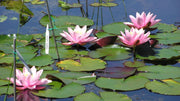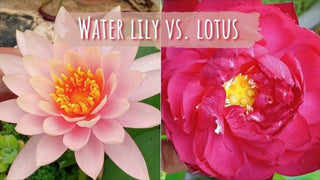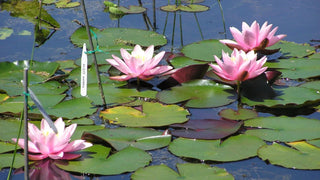
A backyard pond is more than a reflective surface; it’s a living canvas. Add the right water plants and the picture changes completely: fish feel secure, algae retreats, blooms open like fireworks, and the whole scene hums with life. Yet many pond keepers hesitate—especially when the pond is deeper than the typical patio tub. “Will my lilies reach the surface?” “Won’t the soil make a mess?” “How do you plant water lilies in a pond without ruining the liner?”
If those questions sound familiar, you’re in the right place. This guide walks you through planting water plants in a pond, step-by-step, with real-world tips for shallow shelves and deep-water pockets. You’ll also see where smart gear—such as Poposoap’s energy-saving filters and solar fountains—fits into a thriving, low-maintenance ecosystem. Let’s dig in.
1. Why Water Plants Matter in Your Pond

Water plants do far more than they decorate. Floating leaves shade fish from summer heat, submerged stems release oxygen, and root zones absorb excess nitrates that would otherwise feed green water. In short, plants are your cheapest biological filter and the ultimate insurance policy against string algae and temperature swings. Skipping them is like leaving half the filtration budget on the table.
2. Choosing the Right Water Plants

A balanced pond blends three plant types:
- Floaters – Water lettuce, hyacinth. Fast nutrient sponges but tender to frost.
- Marginals – Pickerel, dwarf cattail. Best for shelves 10-20 cm deep.
- Deep-water lilies – Nymphaea varieties that root 30–90 cm down and spread broad pads.
When you’re focused on how to plant water lilies in a pond, variety matters. Hardy lilies (e.g., Nymphaea ‘Marliacea Albida’) overwinter in mud, while tropical lilies need 20 °C water and die back in cold zones. Measure your pond depth first: if the planting shelf sits 70 cm below the surface, choose cultivars rated for that depth and consider tall-crowned planting containers to lift rhizomes closer to sunlight.
3. When and Where to Plant Water Lilies
A water temperature above 18 °C is the sweet spot; lilies planted into chilly mud often rot. In temperate regions that means late spring. Aim for six hours of sun, with open water overhead so pads can float unshaded. Too close to a waterfall and constant ripples keeps leaves submerged; too close to the skimmer and pads may clog the door. Mark a still, sunny quadrant and you’re halfway there.
4. How to Plant Water Lilies—Step-by-Step Guide

- Prep a planting basket – Use a perforated aquatic pot or sturdy crate lined with hessian. The holes let water in, but the cloth holds soil.
- Mix the soil – Plain Garden dirt (clay loam preferred) plus a handful of aquatic fertilizer tabs. Avoid peat and compost: they float and cloud water.
- Position the rhizome – Set it at a 45° angle, crown up, growth tip just below soil level. Backfill gently.
- Top with gravel – A 2 cm cap of washed pea gravel keeps koi from digging.
- Lower slowly – Start the basket on a milk crate so the crown sits 20 cm below the surface. As leaves reach for light, step the pot down each week until it rests on the pond floor—even 90 cm deep. This graduated method is the secret to how to plant water lilies in a deep pond without starving them from sunlight.
- Secure – If turtles or large koi abound, place a rock on one corner of the basket so it can’t tip.
Within three to six weeks, you’ll see round leaves floating and the first buds forming. That’s also the moment to ease back on fish feeding; the plants now handle part of the filtration load.
5. Pro Tips for Success
- Deadhead weekly – Snip spent blooms and yellowing pads at the base. The plant pours energy into new flowers, not decay.
- Thin aggressive floaters – A basket of hyacinth can double in a month; compost half before it blocks sunlight.
- Fertilize sparingly – Tablets once a month are plenty. Overdose and you feed algae too.
- Rotate containers – Give each lily a quarter-turn weekly so pads spread evenly instead of clustering toward the sun.
6. Common Issues & How to Solve Them

Murky water after planting
Fine clay escaping the basket clouds water. Place a sheet of burlap over the soil before graveling—or let the pond filter clear it overnight. A Poposoap Pond Filter Box with layered foams and bio-ceramic rings traps the silt quickly and converts the released ammonia, protecting tender roots.
Leaves scorched or torn
Pads curling at the edges may sit too close to a splashing fountain. Shift the container or swap high-jet nozzles for a gentle spray.
Roots rotting in soggy soil
Overly wet baskets smell sulfurous. The fix is better oxygenation: add a Poposoap Solar Pond Aerator near the basket; rising bubbles draw oxygen-rich water through the root zone.
7. Combine with Smart Pond Gear for a Healthy Ecosystem

- Pond Filters – A properly sized Poposoap Filter Box removes leaf debris before it decays, sparing lotus and lily roots from nutrient spikes. Its tool-free latch means you empty pads in under a minute.
- Solar Fountains – Place a Poposoap Solar Fountain Kit at the opposite end of the pond. The gentle circulation discourages mosquitoes yet leaves the lily quadrant calm so pads float undisturbed.
- Aerators – Night-time oxygen dips stress fish and plants alike. A whisper-quiet Poposoap Solar Aerator lifts bottom water, preventing toxic gas pockets and keeping the sediment layer sweet.
- Pond Lights – Warm-white Poposoap LED Pond Lights tucked under a stone ledge cast an upward glow that turns evening blooms into a moonlit showpiece without heating the water.
Using equipment that shares Poposoap’s rugged ABS shells and quick-connect fittings means everything snaps together, stays waterproof, and embodies the brand’s promise of “hassle-free garden products that bring beauty and joy.”
8. Conclusion
Learning how to plant water lilies in a pond—or any aquatic plant—boils down to three rules: give the roots soil, give the leaves sunlight, and give the water stability. Follow the depth-graduation trick and you can even master how to plant water lilies in a deep pond with ease. Back it up with solid filtration, gentle solar circulation, and an oxygen safety net, and your lilies will reward you for years with shade, fragrance, and unmatched color.
So, gather a basket, some pea gravel, and a young rhizome. Slide it into position, step it deeper week by week, and watch a bare patch of water transform into a floating garden—proof that planting water plants in a pond isn’t a chore; it’s the fastest way to let your water feature blossom into the star of the backyard.







